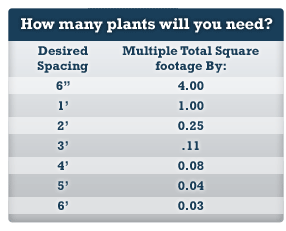Planting: Shrubs, Ground Covers and Flowers
 Follow these tips for a successful planting and healthy plants:
Follow these tips for a successful planting and healthy plants:
1. A good time to plant seedling or bare root ground covers is in the early spring or early fall to allow plant roots to become established before the onset of summer heat or winter cold.
2. Remember to group plants according to their watering needs.
3. Rototill two to three inches of compost into the soil to a depth of eight to 10 inches. If the terrain is uneven or rocky, or if the plants are one gallon or larger, dig individual planting holes from four inches to two feet apart, depending on your budget and desired look (Figure 3-7).
4. Determine the recommended spacing between each plant and plan each plant's distance based on the chart. For example, one-foot plant spacing in a 20-square-foot area needs 20 plants. Stagger the plants in a checkerboard pattern as shown in Figure 3-8.
5. Dig a hole two to three times wider and as deep as the plant root ball (Figures 3-9a, 3-9b and 3-9c). Backfill the hole with 50 percent organic matter and 50 percent natural soil, then pack the soil firmly around the roots, keeping the top of root ball even with existing grade. Leave a slight depression around each plant to hold water, then water thoroughly. Apply a one- to two-inch layer of organic mulch around each plant, being careful not to cover the growing crowns.
6. Lightly pruning plants and flowers when they're first planted reduces transplant shock and encourages growth. Once established, most ground covers will need little care or pruning, and they'll only need fertilization once each spring with an all-purpose fertilizer.
7. Since flowers are typically planted in groups or masses, prepare the flower bed all at one time instead of digging individual holes. Perennials require well-drained soil, which you can foster by adding two to three inches of bark humus, bark compost, or aged animal manure (not steer manure) over the planting area. In heavy clay soils, add up to 50 percent organic matter to your flower bed.
Hint: A handful of bone meal or triple phosphate rototilled into or added to soil surface encourages root growth and flower formation. Adding aged manure and bone meal in the fall of each year will provide the best floral display the following year.
Other tips to remember include:
- Gently loosen roots prior to planting (Figure 3-10). If roots are tightly compressed, make a few one-inch cuts with a knife down the length of the root ball. New roots will grow in the area of the cuts.
- After planting and watering, add soil as needed to maintain a level grade, making sure not to bury plant crown.
- Mulch applied around plant will conserve water and reduce weed growth.
